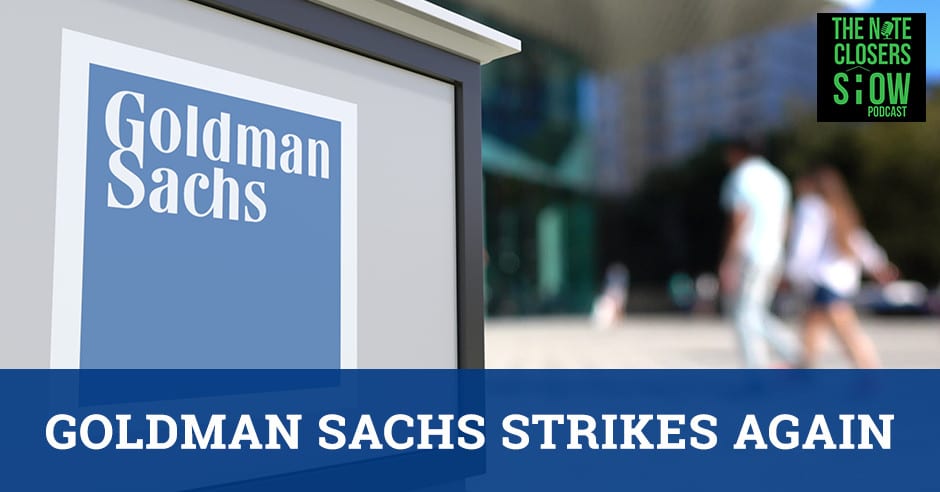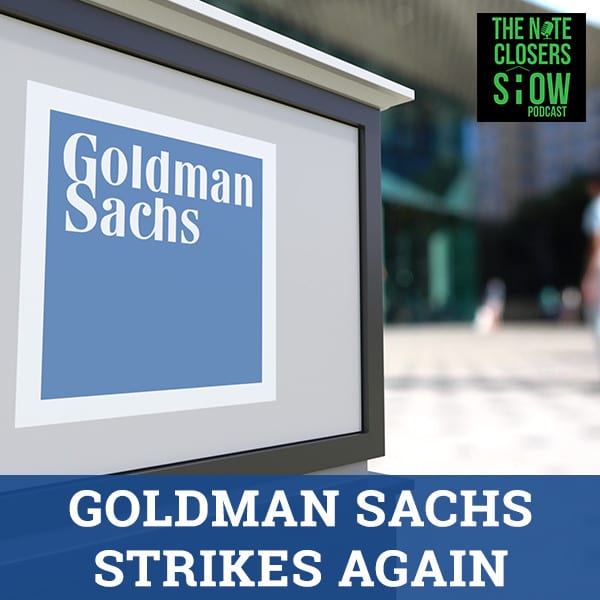
Goldman Sachs strikes again. They’re generating a close on another large portfolio of nonperforming notes from Fannie Mae. They bought a tremendous amount of 11,000 loans with $1.64 billion in unpaid balance. What does that mean to us? What does this mean to Goldman Sachs and what is the overall underlying ripple effect across the note industry? You’ve got to realize is Goldman Sachs got banged up really bad for a nasty $5 billion fine, and they’ve been buying these non-performing notes as part of the payback because every dollar in debt forgiveness and modification gets credited towards their fines. Scott discusses the current sale of 11,000 loans that Fannie Mae is selling to Goldman Sachs and what it means for us as note investors. Along the way, we’re surprised with a call from the company providing the due diligence on the trades.
—
Listen to the podcast here:
Goldman Sachs Strikes Again
I thought we’d spend some time talking about the article that came out from HousingWire about Goldman Sachs striking again. It’s about Goldman Sachs getting ready to close on another large portfolio of nonperforming notes from Fannie Mae. They bought a tremendous amount of 11,000 loans, which was pretty ridiculous. The article goes on to say, “$1.64 billion in unpaid balance. Winner of the thirteenth non-performing sale of Fannie Mae is Goldman Sachs.” They announced it as a different company, MTGLQ Investors. Goldman Sachs is the company behind it. The sale includes about 9,800 loans of about $1.64 billion in UPB and it’s divided among four different pools. They’re also working with Bank of America Merrill Lynch and then a company called the Williams Capital Group to help dive for it.
The total sales are 11,000 nonperforming loans with unpaid balance of $1.84 billion. The company explained that a small portion would be sold was a Community Impact Pool. Those are smaller loan pools that are divided up geographically into different areas. It was in Cook County, New York, New Jersey, Miami and I believe Baltimore was the other area. Those are targeted toward minority on business like women-owned, Hispanic-owned and smaller investment companies. They’ve taken out a full pool, but they’re offered the smaller pools in the rougher areas to get things done.
Out of the four pools, group one is 2,300 loans, a weighted BPO loan-to-value is at 80%, average loan by net pool is $151,000. Group Two was the largest pool of the four, which is 3,182 loans. The average loan size of $150,000. Weighted average of note rate is 5.21%, 40 months from delinquency. The first pool is just 25 months of delinquency. Weighted average BPO loan-to-value ratio is 63%. Group three is 1,403 loans. UPB on average is $150,000. It’s almost exactly the same size of loans on these first two. It has 40 months of delinquency, weighted average loans of 63%. The fourth pool is 2,881 loans, $595 million is the loan balance. Average loan size of $206,000, the delinquency, 39 months of delinquency, average BPO loan-to-value ratio is 120%. The second highest bid for the pool was at 81.5% of unpaid principal balance. They were all purchased on an all-or-none basis. Whoever bought these had to take them all at the same time.
Why is that important for us? What I did is I’ve reached out to the company helping Bank of America Merrill Lynch and Goldman Sachs in Texas. I reached out to the Williams Capital Group. I talked to the gentleman. He forwarded me to the call desk, it went straight to voicemail. What does that tell you? They’re getting a lot of phone calls already about potential deals. One of the funny things is when Countrywide went out of business, they had a very similar situation set up on a negative side. They left a voicemail set up and they had one person monitoring it. I don’t know how many phone calls I made, but finally the guy called me back. They’re getting bombarded with phones calls to request information about the loans they’re going to build. What does that mean to us? What does this mean to Goldman Sachs? What is the overall underlying, ripple effects across the note industry?
One thing you’ve got to realize, Goldman Sachs got banged up bad for a nasty $5 billion fine. One of the things that they have been doing buying these non-performing as part of the payback or the fine schedule was that if for every dollar that they forgive in modifications, debt forgiveness, it gets credited towards their fines. If somebody owes $100,000 and they forgive $20,000 and then reset or modify the loan for $80,000, they get to write off that $20,000 straight off of their bill. That’s why they can pay over 81.5% of UPB on this stuff because not only are they getting a dollar for a dollar discount off of their big fine, they’ve also got really cheap money. If they’ve got money that’s coming in and they’re paying at 0.5%, they’re going to make 5% return on investment to themselves. That’s 10% of what their money costs are.
They’re outbidding everybody else because they got cheaper money now. These Community Impact Pools, they are these pools in the rougher areas of the country, the longer foreclosure time frames. Where’s the opportunity for us as note investors? I think that’s what everybody wants to know. For us as non-performing loan investors buying institutional debt, I think you’ve got to do a couple of things. One, it’s like what we talked a little bit about on a past episode about going bigger. You’ve got to expect to buy more. You’ve got to take the good with the bad. While the average is on these pools are $150,000, that doesn’t mean they don’t have stuff in the low balance and stuff in the high balance. I haven’t gone in and looked at the actual portfolio breakdown of those assets. I’d be willing to bet they have some stuff that’s higher value and stuff that’s lower value to get into that weighted average of $150,000 UPB. It’s going to take a while for Williams Capital Group, Merrill Lynch Bank of America to figure out what they’ve got on their books along with how Goldman Sachs is going to approach this stuff.
I’m researching and doing some stuff to find out how Goldman Sachs is doing on the portfolios that they’ve previously bought. They are doing well enough to buy another 11,000 loans at a price point that we as investors wouldn’t necessarily buy on a one-off basis. I wouldn’t buy anything at $0.82 on the dollar. It all depends on how they’re able to offset those loss. They’re buying debt at a discount and still getting the dollar for dollar write-off off their books. They got a little banking creativity on their finance side. What does this mean for you, me note investors? You’ve got to go big. You’ve got to expect to buy more in bulk. I’m talking and going out and buying 700 ones. I’m saying maybe five, maybe ten, maybe $500,000 tranche. Expect to buy a little bit bigger. It also is not going to hurt to ask if we buy something good, throw something in that’s necessarily the lower level side of the portfolio what the bank may have or in this case, a fund.

Goldman Sachs: If we buy something good, throw something in that’s necessarily the lower level side of the portfolio.
One thing you’ve got to realize about funds that deal with the stuff, they’re really breaking the portfolio down probably in three fashions, which is pretty normal in the industry. You take your A, B and C assets. You rank them where A is the cream of the crop, the pretty, the stuff that’s going to work out for you. It’s value above what you owe. They’re paying 81% of UPB. They specifically probably have seen the fact that the value of the assets had rebounded beyond what’s owed, where they’re no longer upside down. We all agree the country has rebounded back pretty strong in a lot of areas, especially in the higher value stuff which rebounded faster than lower value stuff. Excluding areas where you have longer foreclosure timeframes, hence the Community Impact Pools.
If you’re an investor in those areas, great, maybe you can reach out especially if you’re a minority-owned, woman-owned business. Reach out to some of those companies. Reach out to the Williams Capital Group to find out, get on their radar as a Community Impact bidder. Oftentimes in those areas, you might be able to get something that makes sense.
—
This is Scott. How’s it going? Thank you for calling me back. It was faster than I expected.
No problem. Just fill me in on what you’d like to accomplish so that I can see if I can help.
I understand you are working on the trade with Goldman Sachs on the recent Fannie Mae Pool, the 11,000 loans, correct?
Yes. We are an advisor to Fannie Mae on that transaction.
You aren’t handling any of the Community Impact Pools on that?
We are the advisors on the entire transaction.
I’m an active note investor buying portfolios of loans. Maybe you can direct me in the right direction to the person to see which company or who I need to talk to you about getting on the radar as a buyer to potentially bid off some assets.
You are interested in buying or joining in the auction.
Maybe not joining the auction because I’m not going to be that big of a heavy hitter. Definitely talking to the company afterwards. Maybe buying a smaller tranche. I represent a group of other investors that we buy on a regular basis. Not billions of dollars but we’re definitely buying millions.
Do you buy $5 million or less? The smallest I’ve ever done has been $15 million. This pool, the CIP was $134 million. That was a pretty sizable program. For you to be able to speak to the winners and ask them whether they want to offer any portion or any specific loan in the pool, that’s after you see the press release of who won. For example, the Goldman piece came out, so it wouldn’t be us.
It would be the winners, which it’s easy to get access to that, Goldman being the one of the biggest pool. Then there will be a press release advising you on who the CIP winner is. If you look at all of the previous winners, whether they were a non-profit organization, you could reach out to them directly and see if that’s something that they would like to pursue with you. They’re all online. Their contact, their phone number, their email, everything is all online. You just pull up their organization name and you get their access.
—
I would not normally have answered the phone. I usually put it on private but I left it just in case we did get a phone call back and I’m actually surprised. That’s the fastest I’ve ever gotten a phone call back from anybody in New York. She said reaching out to Fannie Mae, checking out who were the winners of those trades and then calling them directly. She said before that the lowest amount was $15 million that they’ve often sold off in small Community Impact Pools. On these Community Impact Pools, you’ve got to be prepared that it’s an area that’s probably going to take longer to work through. Only here on The Note Closer’s Show do you get that instant impact information on what’s going on in the market. Let’s talk about that. You could go on here to see exactly who the winners are. It gives you all the information in FannieMae.com.
All that information is online and reaching out to say, “What do you have to sell? What kind of pools are you selling off?” I’ve always said this about the trickle-down aspect of things is you have pools that get bought in big bulk. They get carved up. Most hedge funds will take a look at their portfolio and will divvy it up in A, B and C assets. The A portfolio, cream of the crop. B is going to be the middle range. C is going to be stuff that’s the bottom of the barrel, the trash up, the empty, the ugly houses. Every hedge fund or investment company has a little bit of different ranking to that stuff. In some banks, they rank their performing papers. A if it’s non-performing, dramatically default. They get the zero value, they don’t want it. Oftentimes you can move that stuff off and pickup stuff cheap on pennies on the dollar back then. It’s changed, but that’s what they’re doing.
They’ve got these four pools plus the Community Impactful Pool. We’re looking at what’s the best, what’s the middle, what’s the bottom of the barrel. The bottom of the barrel for them based on their evaluation, occupied, square footage, year built. When you look at it, you have at least 30 to 40 months of average delinquency and you’re talking another two months, then we’re going to be at 40 months across the board for all of those portfolios or 45 across the board. There are opportunities If you figure it’s going to take another month or two for them to get their work cut out for them. Their borrower reaches out to begin, you’re talking four years, if not five years in some cases or getting close to it where they actually can do something. What are they going to ultimately do? I will tell you exactly what Bank of America did, which I would expect that probably Goldman Sachs is going to do something very similar. On these loans that they buy through their parent company, they’re going to be reaching out to the borrowers and trying to immediately engage them for modification or reinstatement, “Give us a phone call. Here’s what your approved debt.” That’s the low-hanging fruit.

Goldman Sachs: Reaching out to the servicers is often a really great play for finances.
If they can get their borrowers to respond to letters or mailers in an immediate fashion, that’s going to speed up and be the most active modification. We do the same thing. When we buy a portfolio, we immediately send the letter out within two weeks of closing, separate of our servicing company just to get the borrower to reach out to us. The next phase is going to be much more active. That’s going to whoever’s servicing these loans with active phone call outs. Once that worked out, then they’ll start litigation. They’ll start the foreclosure process. They’ll start retaining attorneys and realtors. At the same time, to start getting that ball rolling, you’re going to see the foreclosure terms. You’re going to see that with these loans and stuff like that happens. As it trickles down, what’s the pricing aspect of those things look like for us? It’s just going to take time. It’s going to take us probably six to twelve months once they get them in house to do anything valuable with them because of the timeline, timeframe and the servicing aspect of things.
That’s why I think reaching out to the servicers is often a really great play for finances. Reaching out to the servicing companies and talking about business development officers, “What do you have on your portfolio that we can rid of? How many of your clients have portfolios that maybe looking to move some of that off their books and we’re glad to let you retain servicing?” That’s one of the biggest things that you see happens a lot of times, especially banks or other things. You’ve probably seen some of these where they’ve sold their portfolio off, but they retained the servicing side. It we’ve sold the portfolio but we’re going to keep the servicing or the bank is buying a portfolio and they want to keep it in the servicing side, because it’s less disruptive. Rarely do you see big companies moving thousands of assets from one service to another. They want to keep that servicing relationship intact or buy the servicing company because let’s understand, that’s the most impactful part of it. They don’t want to rely on another month to two months transfer.
On the smaller side with us, it happens all the time because we have a relationship and it’s not nearly as impactful as it is when you’ve got 11,000 loans. Sometimes you just eat your expenses when you’re begging because you don’t want to disrupt. Whereas smaller investors, we’re more flexible. We can make that up with our reach out or creative solutions. I did not expect that to happen, to get a phone call back from New York immediately. If you are making some phone calls, you’ve got to go directly to the source now. It all comes down to the marketing side of things as well too. You’ve got to be willing to market. You’ve got to be getting your ducks out, getting work done for you. That’s the most important thing I can tell you in this industry.
We get excited about the notes. We get excited about the tapes when you start looking at the assets. It’s just not that though. To be able to buy those, you’ve got to get the word out because I guarantee most of us aren’t going to write a $15 million check. Most of us aren’t going to do all the work. You’ve got to look at growing your business, expanding and going bigger and knocking some things out of the park to make things beneficial for you in the long run.
This is what I would look at. On these firms that are buying these large portfolios, those winning bidders that are going through that stuff, they’re going to get bombarded on the front end for their good stuff. It happens. Every tape, every pool, somebody wants to come in and buy all the good stuff. They don’t want to pay anyone since they bought for the good stuff and there’s that back and forth. That’s why it’s important to find what the pricing is. Keep in mind too that at some point, Goldman Sachs or whoever it is, is going to have some bottom of the barrel assets. They’re going to have some stuff that they just don’t value for anything. What do you do with that? You work through that. “I’m looking for stuffs. What’s your bottom of the barrel that you want you to get off your books? That’s where you wholesale, that’s where you’re looking to make something out of nothing. Oftentimes when you get the bottom of the barrel stuff, the banks already made their profits. They’ve already written that bottom of barrel stuff off. They’re willing to give it for transaction fee.

Goldman Sachs: Don’t expect to go and make an offer and be paying less than what they paid, especially on the good stuff. It’s going to be expensive.
If you can get creative with the owner financing of lot, or wholesale into local fix and flippers who want to do the work and the heavy lifting, often you can make some money on that by putting yourself in between. That takes time. It takes having a very valuable network of people across the country and being able to mark it on a regular basis. That’s where I would recommend that we play at. If you can put something together and buy some decent stuff in areas, that’s great for you. Don’t expect to go and make an offer and be paying less than what they paid, especially on the good stuff. It’s going to be expensive. That’s why I say it doesn’t make sense for us to be playing up in that aspect of things because it’s overpriced. It’s hard to make money when you’re paying over 81.5% of UPB. You’ve got to figure out where the cracks are, where the crumbs are to make the money that you want to be making.
This is where you see the auxiliary services come in. That’s why you see ProTitleUSA has been very busy over the last few years running large title report orders for Fannie and Freddie and others. For those who are listening on iTunes, you can always catch the video replays by going to, WeCloseNotes.tv as well. It’s where we have all our video replays up there if you like the video versus listening on iTunes or Stitcher. There’s opportunity everywhere. You just got to know how to dive down and be flexible and adjust your business model, if it’s something you want to do. Have a great day and we’ll see you all at the top.
Important Links
- Goldman Sachs – Article Link on HousingWire
- Williams Capital Group
- FannieMae.com
- ProTitleUSA
- Note Closers Show on iTunes
- Note Closers Show on Stitcher

